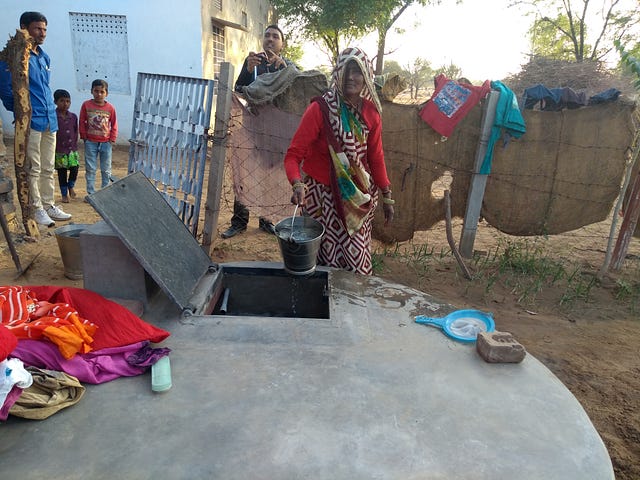
Rainwater harvesting is something we, in our urban setting, have not got accustomed to. But it is high time, isn’t it? Hear yourself out the next time the water supply is disrupted and you have to go to office grumpy and dirty. Yes, it applies to me too.
Now imagine if you had to spend every day, through summer, walking to office through dirt and dust, without taking a bath at all. Add to that having to spend the day on the last few drops of water, sometimes unclean. I guess now you’d like to step forward and do something about it. Maybe the experience I am about to share will help you do your bit — both for yourself and for the ones actually suffering.
My first glimpse of rural development
I have a rather interesting work role in GiveIndia, which allows me to travel — from cities to rural areas to even more remote corners — to do credibility audits of organisations. Most of the travels also involve seeing the program implementation and meeting the beneficiaries. Might I add, GiveIndia is the largest and most trustworthy giving platform for donors, and I may have a small role into contributing to that. Just a tiny speck!
On one such rather fortunate solo work-trip of mine to Rajasthan, I gained an experience that changed a part of me, and is still doing so — drop by drop, each day.
I moved out of my comfy dorm bed of Zostel and stepped into the colourful flea markets of Hawa Mahal road, and then onto the drab and dull highway road. I sped across the sleek grey highway, the rough desert vegetation on each side, parched, dry and lifeless, to reach an NGO that works in rural development in Khedi Milak. The office of Gram Chetna Kendra, was located in the middle of nowhere. It does not have a place even on Google Maps. Naturally, I had a tough time reaching there. GiveIndia’s point of contact, Prahlad, welcomed me in, along with the CEO Mr Om Prakash Sharma, who instantly won my heart by offering me food!
Rural communities building their own solutions

Something about the small campus of the organisation really struck a chord with me — the offices run on solar power till about 5 pm! And this was in an area of almost zero electricity supply. That also meant that the employees travelled miles each day.
It was mentioned many times across the visit that this area, upto a radius of fifty kilometres is a part of the saltwater lake Sambhar. Sambhar lake dried up and left behind dry soil and underground water with a very high content of salt, unfit for any kind of consumption.
Therefore the only solution towards the water scarcity was rainwater harvesting, and Gram Chetna Kendra, with the support of GiveIndia, is building rainwater harvesting ‘taankas’ to give the local communities a chance at a healthy and safe life.
The program works very simply. Gram Chetna Kendra has a set budget and dimension for the construction of each tank — a certain amount of cement, stones, fittings, like pipes and chambers, sand and grits, and a budget for special skills labour or mason charges. The local people here live in conditions of extreme poverty — with no water or electricity. Houses are identified and the budget is explained. The families procure the material, special labour and put their own time and effort to build these taankas which can store water from one season of rain for the next 10–11 months.
I was amazed at how smart the solution was, and ashamed of how baselessly we complain every time it rains, disrupting our traffic and peace of mind! People here were building tanks from scratch in the middle of the desert, the very same one that I cursed while walking a few metres through, with ants and thorns pricking my feet, my lips and throat dry from the want of water.
With mixed feelings of awe and guilt, I met two women, Meera Devi and Koshlya Kawar, who had contributed to building the taanka for their homes. They, happily, amidst broken communication, demonstrated how they pull the water out. They even explained what materials they procured, how much time it took to build and how they are using it. Astonishingly enough, they take only 6–7 days to complete the construction. And it does not matter which season it is, except for monsoons. The rainwater collected lasts almost a year, serving a family of 5–6, and is absolutely safe for consumption as it is kept locked, without any scope for contamination.
But there was one glaring truth that bothered me — these tank constructions are possible only when a donation is received. And we urbanites, with funds to spare, can start with baby steps this Environment Day, to help bring water to villages. And while we are at it, perhaps save our own resources as well. A thing to think about?
Good news is, for just INR 1758 per month, you can help build a rainwater harvesting tank! GCK is our GiveAssured partner, and with your donation, they will ensure safe water for families in the desert!
Discover more from Give.do
Subscribe to get the latest posts to your email.

Leave a Reply